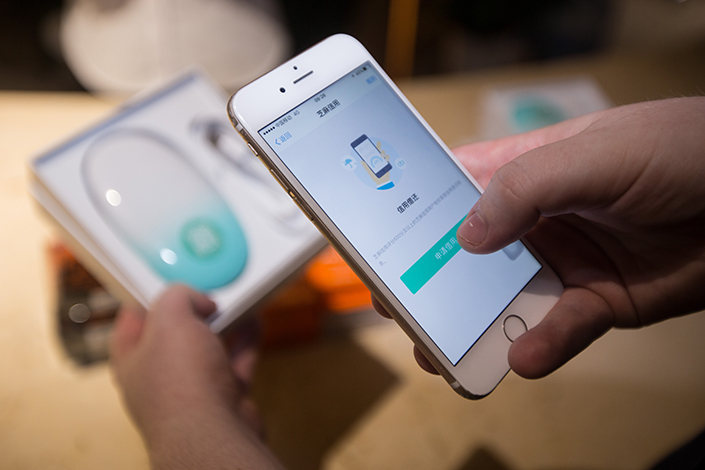Venture Cash Puts Jolt Into Portable Phone-Charging Business

(Beijing) — Investors are putting fresh juice into the portable phone-charging business in China, as they bankroll rentable power units that are placed in stores, malls and office complexes.
The investment in rental units comes as sales in purchased power packs have flattened out, as users need to buy a new unit only when the old one’s natural lifespan — one or two years — expires.
The rental process is simple. A store customer approaches a microwave-oven-size cube — a power station — that houses small portable battery chargers called power banks. To retrieve a power bank, the customer scans a QR code, pays a deposit and a fee of about 1 yuan (14.5 U.S. cents) per hour, and the station dispenses the power bank.
The user can then leave the store if they wish as long as they return the power bank to any power station run by the same operator. An operator may have numerous stations in any given area — a shopping mall, an airport, or an office complex.
Venture cash is rushing to back power-station vendors, such as Imlaidian, which this week received a $20 million investment from SIG China and Redpoint Ventures China. Imlaidian leases its vending-machine-style rental cabinets for use in shopping centers and waiting rooms.
Other notable investments went to AnkerBox, which last month received hundreds of millions of yuan from IDG Capital and Shenzhen-listed battery maker Sunwoda, and to tabletop charging-dock company Xiaodian, which received over 10 million yuan in funding from several Chinese venture capital funds, including In Capital and GSR Ventures.
“Sometimes the demand for something is not obvious until you put it in front of the users,” said Yan Jing, chief technology officer of Ankerbox. “Over a year ago, no one would have believed that the bike rental market would be worth billions of dollars.” Yan said the same untapped potential lies in power banks, which many find too bulky to carry around every day.
Investors agree that there is real demand for charging services, especially with today’s power-hungry devices. “The need to charge is a high-frequency activity. We’ve all been in a situation where we are stranded with a dead phone,” said Ken Xu, an executive at venture-capital firm Gobi Partners. “But as with all ‘sharing’ or rental business models, the one-time investment in assets is very capital-intensive.”
The speed at which power bank firms are deploying their products is akin to the early stages of the bike-sharing race in China. In the span of a few months, market leaders have added tens of thousands of portable power banks to major cities.
Shopping centers and cafes see multiple incentives to housing the power stations and portable banks. The electricity bills that the stores must pay to charge the stations themselves are insignificant compared to the revenue they receive from customers lingering around and purchasing goods. Furthermore, as competition heats up, vendors of the stations are willing to deliver the units door-to-door.
“This saves us the hassle and cost of preparing dozens of different cables and chargers frequently requested by guests,” said Xu Qiangqiang, manager of the Kafelaku cafe in Beijing’s Sanlitun Soho complex.
Xu said that customers often find his coffee shop by using an app that directs them to the nearest charging station.
“These things are like a free advertisement for our cafe, and there are people who actually come to sit for a cup while waiting for their phone to fuel up,” he said.
Currently, the battery-rental vendors are neither paying nor charging shops to carry their units. While charging stations seem to bring in customers and thus revenue to stores, the vendors who lease them said they will offer further incentives for stores to house the units. “In return for their space, we may offer free advertising for the shops on our station screens,” Imlaidian Chief Operating Officer Jacky Huang said.
In fact, Huang said, the company expects to rely on advertising for around half of its revenue.
“But what the malls value more than anything else is having the shoppers hang around for the extra two hours its takes to charge their phones,” he said.
Shopping at a mall in downtown Beijing, a 20-something fashion designer surnamed Hao can see that her phone’s power level is close to zero. “These things are a life saver. It’s only 3 in the afternoon,” she said with a sense of urgency, as a slim power bank is dispensed from an Imlaidian cabinet.
But after learning that she has to pay 10 yuan to buy a cable on top of a 1 kuai hourly charge and a 100 yuan deposit, she returns the bank back into its slot. “I guess I don’t need power that bad.”
Contact reporter April Ma (fangjingma@caixin.com)

- 1PDD Fires Government Relations Staff After Fistfight With Regulators
- 2China Ramps Up Effort to Offload Vast Supply of Unsold Homes
- 3China’s Elite-Focused Schools Are Failing Most Students, Top Educators Say
- 4In Depth: China’s Developers Try to Modernize After Surge in Subpar Homes
- 5Cover Story: Trading by Algorithm: Who is Responsible When AI Calls the Shots?
- 1Power To The People: Pintec Serves A Booming Consumer Class
- 2Largest hotel group in Europe accepts UnionPay
- 3UnionPay mobile QuickPass debuts in Hong Kong
- 4UnionPay International launches premium catering privilege U Dining Collection
- 5UnionPay International’s U Plan has covered over 1600 stores overseas






